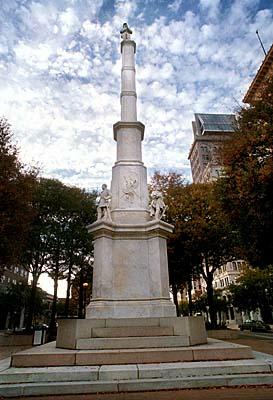|
Elmira Prison Camp OnLine Library |
It's probably fitting that upon exiting the News Building on Augusta's Broad Street, one of the first things you'll see is a statue modeled after Confederate soldier Berry Benson.
While the monument honors Mr. Benson and his military counterparts, his journalistic skills are lesser known.
A native of Hamburg, S.C., a ghost town by North Augusta just across the Gordon Highway bridge, Mr. Benson's reputation now glistens in perpetuity -- based on his self-chronicled battlefield exploits.
Although a proven soldier, Mr. Benson's relevance as a Civil War-era scribe and public accountant went largely unnoticed until the early 1960s.
Mr. Benson started writing about his war experiences 13 years after the Confederate fall at Appomattox, Va. He originally targeted a readership of family and friends.
In the same year astronaut John Glenn made history as the first American in space (1962), Mr. Benson's recollections of another significant page in American history were published in Berry Benson's Civil War Book: Memoirs of a Confederate Scout and Sharpshooter.
The 224-page book, reissued in 1993 by the University of Georgia Press, offers horrifying depictions of the Civil War and the pain felt on both sides of the conflict.
Mr. Benson describes how malnourished Rebel soldiers scrutinized animal manure hoping to find grain as a diet supplement. While incarcerated at New York State's Elmira Prison, he noted how prisoners of war humored themselves by chasing rats.
The soldier also tells how he escaped a Maryland prison by swimming across the Chesapeake Bay and Potomac River. According to the book, Mr. Benson and his younger brother never submitted to defeat, and walked home with rifles in hand after Confederate Gen. Robert E. Lee's surrender on April 9, 1865.
While some locals thought Augusta's downtown Confederate monument was built in direct tribute to Mr. Benson, Augusta historian Edward J. Cashin said the shrine was meant to memorialize the anonymous soldier.
``They felt the enlisted man deserved the attention, so they put him atop the pinnacle,'' Dr. Cashin said in an interview with The Augusta Chronicle in February 1993.
The monument has garnered its share of controversy. Some authorities believe it is the only statuary in the world with four generals looking up to a lower-ranking soldier.
The base of the monument, coupled with Mr. Benson's statue, is 76 feet high. Meanwhile, life-size statues of Gens. Lee, T.J. ``Stonewall'' Jackson, Thomas R.R. Cobb and W.H.T. Walker appear as simple accompaniment for the statuesque and goateed Mr. Benson.
Constructed in 1875 by an Italian artist, the white marble memorial climaxed a 10-year project headed by the Augusta Ladies Memorial Association. It was officially dedicated on Oct. 31, 1878.
Had it not been for Mrs. O.C. Lee of Augusta, the source of the monument's inscription might have remained a mystery beyond 1957:
``No nation rose so white and fair. None fell so pure of crime.'
Mrs. Lee discovered the excerpt was taken from a poem written by an Englishman, Phillip Worsley, in a letter to Gen. Lee.
In his final years, Mr. Benson was a participant in Memorial Day parades on Broad Street. Legend has it he never looked at his statue when marching past.
He died in North Augusta on New Year's Day in 1923.
